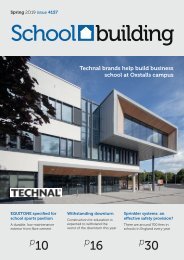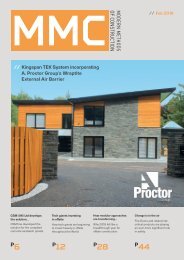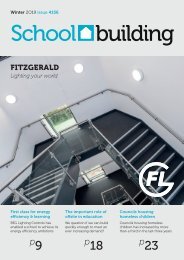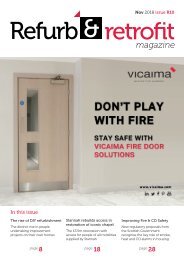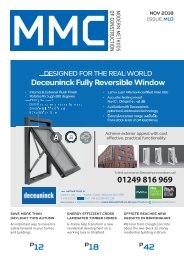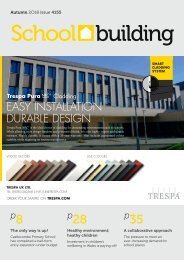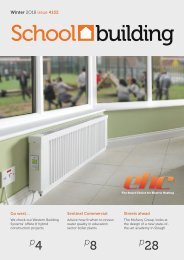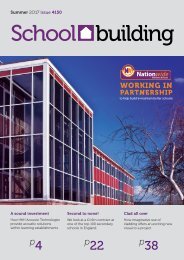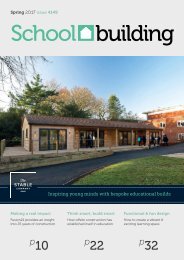You also want an ePaper? Increase the reach of your titles
YUMPU automatically turns print PDFs into web optimized ePapers that Google loves.
LED is the Jewel in Lighting’s Crown<br />
By Stephen Hurrell, Divisional Managing Director - UK Projects, Aurora Group<br />
There are several misconceptions about<br />
LED lighting, principally that LED<br />
lighting prices will go down so it pays<br />
to wait; LEDs are so efficient that controls<br />
are unnecessary; and that LEDs don’t work<br />
well in high-temperature environments.<br />
A<strong>cc</strong>ording to the Energy Savings Trust, LED<br />
offers best value for money in lighting today;<br />
the price of fittings has come down and, at<br />
the same time, performance has improved<br />
significantly.<br />
The Carbon Trust advocates LED as its<br />
number one efficiency recommendation.<br />
Leading website<br />
www.environmentalleader.com reports that<br />
while switching to LEDs creates a one-time<br />
savings event – typically reducing lighting<br />
energy use by up to 50% – integrated sensing<br />
and controls can nearly double those energy<br />
savings, making controls essential for<br />
maximum savings and project economics.<br />
And did you know that by using LED in<br />
construction, it significantly contributes to<br />
the BREEAM rating of a building as it<br />
typically halves energy consumption of<br />
traditional light sources. Miniaturisation has<br />
also led to a significant reduction in raw<br />
materials utilised in manufacture.<br />
Artificial lighting in buildings is usually<br />
categorised in three ways. The ‘Ambient’<br />
lighting function provides light to the space<br />
to an a<strong>cc</strong>epted level. ‘A<strong>cc</strong>ent’ lighting<br />
highlights certain features and/or attributes.<br />
‘Task’ lighting illuminates specific working<br />
areas to aid visibility.<br />
Lighting Performance<br />
The four key criteria governing LED<br />
performance are thermal management,<br />
optical control, efficacy of light and reliability<br />
of power. So, what are the guiding principles<br />
of best practice in quality manufacturing?<br />
Heat has a negative impact on any LED light<br />
source’s performance. The next generation in<br />
thermal management dissipates heat away<br />
from the LED chip, providing higher quality,<br />
brighter light for longer. There’s also been<br />
continuous improvement in efficacies of LED<br />
chips so the higher the lumens per watt, the<br />
better.<br />
Look for products warranted to L70 to a<br />
stated number of hours. This means you can<br />
expect a light output of 70% of the lumen<br />
performance stated at that period of time<br />
e.g., a 1000 lumen LED luminaire will deliver<br />
at least 700 lumens after six years, based on<br />
burning 4000 hours per year.<br />
An emerging trend in construction is to<br />
insulate the ceiling void by ‘blowing in’ loose<br />
fill insulation as an alternative to loose-laid<br />
products. Loose fill completely encloses the<br />
fitting which could affect LED performance in<br />
inferior downlights.<br />
Biodynamic lighting<br />
Light controls our biological or body clock<br />
and this is known as the circadian rhythm.<br />
New to the market, biodynamic LED lighting<br />
allows people to control their environment<br />
a<strong>cc</strong>ording to need, mood and task, which can<br />
improve performance and motivation.<br />
Changing the colour temperature of the<br />
artificial lightsource (e.g. from extra warm to<br />
warm through to cool) can have a dramatic<br />
effect. Biodynamics is particularly suitable<br />
for dynamic interior projects, retail<br />
applications, and in healthcare and homes<br />
for the elderly.<br />
Enlite LED Lighting Essentials<br />
The Aurora Group has responded to<br />
increased demand for LED by engineering<br />
the Enlite range of 250+ “Lighting<br />
Essentials”. Enlite offers Offsite’s varied<br />
modular business model big performance,<br />
high quality and the best in value to meet<br />
specifications and budgets.<br />
Firm Enlite LED favourites in the <strong>MMC</strong><br />
sector are the E8 TM 8W integrated fire<br />
rated downlights with halogen like<br />
appearance, the ultra-slim E6060 TM<br />
600mm 2 flat panels for commercial<br />
applications, the UniPac TM and LinearPac TM<br />
IP65 linear anti-corrosives which replace<br />
traditional T8 TM s and the vandal resistant<br />
Orbital TM IP66 bulkhead.<br />
Regulatory compliance<br />
Lighting design is a complex issue and part<br />
of a quality manufacturer’s role is to develop<br />
bespoke schemes which will comply with<br />
regulations. A revised version of the Building<br />
Regulations, Part L (2013), came into force in<br />
April 2014. BIM LEVEL 2 was introduced as a<br />
requirement for all government construction<br />
projects this April 2016.<br />
Call: +44 (0) 1727 83 66 11 or visit<br />
enlitelighting.com<br />
Sep/Oct 2016 <strong>M1</strong><br />
<strong>MMC</strong><br />
31



